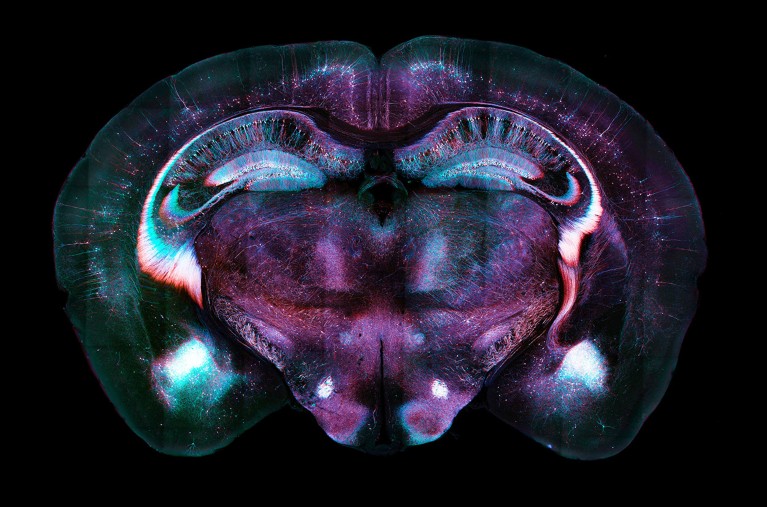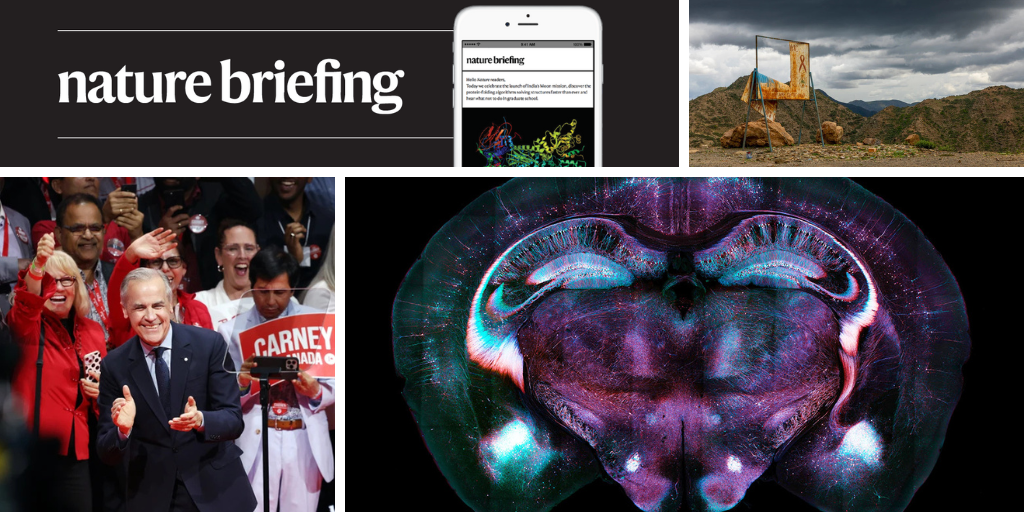You have full access to this article via your institution.
Hello Nature readers, would you like to get this Briefing in your inbox free every day? Sign up here.

A section through a mouse brain showing neuronal cells labelled with fluorescent proteins.Credit: Arthur Chien/Science Photo Library
In mice, dopamine acts on neurons in a brain region called the basolateral amygdala (BLA) to kick-start fear extinction — the overwriting of fearful memories when danger has passed. Researchers found that this dopamine is produced in a separate part of the brain called the ventral tegmental area. Humans have “the same evolutionarily conserved parts of the brain that regulate these fear responses” as mice, says neuroscientist Larry Zweifel, which hints that neurons in the BLA could be a target for drugs to help to treat fear-related conditions such as post traumatic stress disorder.
Reference: Proceedings of the National Academy of Sciences paper
Economist Mark Carney, a former head of the Canadian and UK central banks, will lead Canada as prime minister following Monday’s election. The neophyte politician was voted in as the country faces a trade war and threats to its sovereignty from US president Donald Trump. Although not much was said about science during the run-up to the election, Carney’s platform had a strong focus on boosting science and research, including by tempting scientists across the border — although Canadian scientists are also grappling with funding problems. Carney’s background in climate action raises modest hopes that he will strengthen, or at least retain, Canadian climate policy — despite already killing a controversial (but effective) consumer tax on carbon-emitting fossil fuels.
Researchers have identified 17 risk factors that contribute to the chance of developing stroke, dementia or depression later in life — conditions that can share an underlying mechanism of damage to small blood vessels in the brain. A review of dozens of studies identified several ways to reduce the risk, most of which will not surprise you: eat well, stay physically and mentally active, don’t smoke or drink too much and build healthy relationships. The biggest single thing you can do: keep your blood pressure under control. “If you’re starting to work on one of them, very often you’re actually improving multiple at the same time,” says physician-scientist Sanjula Singh, who co-authored the study. “Choose just a first risk factor and then take it step by step.”
The New York Times | 6 min read
Reference: Journal of Neurology, Neurosurgery & Psychiatry paper
Features & opinion
The Trump administration has wrenched the United States out of international health efforts and paused the country’s staggeringly successful AIDS-relief programme PEPFAR. Still, many observers are hopeful that progress towards ending the AIDS epidemic can be salvaged. Some advocates would like to see countries take ownership of their AIDS response and create programmes that are more accountable than before. Others hope that the world might innovate itself out of the crisis by finding a vaccine or a cure. Still, millions of lives will be lost as low- and middle-income countries scramble — and perhaps fail — to fill funding gaps. “These next four years are gone,” says HIV-vaccine-trials programme manager Pallabi Deb.
A Nature editorial calls on the US Congress to authorize PEPFAR for another five years, so that the programme can complete its mission and so that countries, organizations and funders can strengthen local health systems, invest in primary care and establish local medicine supply chains. “The United States cannot be expected to indefinitely shoulder the burden of ending HIV/AIDS, but suddenly withdrawing life-saving interventions is simply unconscionable,” argues the editorial.
Nature | 12 min read & Nature editorial | 5 min read

Source: Ref. 1
Two concepts have strengthened science and health care in recent decades, writes epidemiologist Genevieve Wojcik: the broad scientific consensus that race does not align with genetic groupings, and growing awareness that diversity matters for sound science and effective policy. Now a rising wave of white nationalism is threatening to undermine that progress, she argues. Wojcik calls on journals, geneticists and educators to push back “by modifying approaches to genetics education, advocating for science, establishing and leading diverse research teams and ensuring that studies embrace and build on the insights obtained about human variation”.
Scientists and death-metal musicians — funded by science fans online — are joining forces to investigate how the singers push their voices to the limit without injuring their vocal cords. “When you are starting to look into the back of the throat and doing these different procedures, you’re just struck automatically with how different each one of [these artists] manoeuvres their larynx or their vocal tract,” says voice scientist Amanda Stark. “There’s just these eye-opening big moments of, like, holy cow, there’s so much uniqueness here on how people can achieve sounds.”
Today I’m delighted to discover the ‘great whale conveyor belt’: thousands of tonnes of nutrient-rich biomass and nitrogen that is brought by migrating gray, humpback, and right whales from colder waters to their wintering grounds in the tropics. Most of the nitrogen comes from urine (of which some species produce up to 950 litres per day). Yet another reason to protect these giants of the ocean’s food web.
While I pop Songs of the Humpback Whale on the hi-fi, why not send me your feedback on this newsletter? Your e-mails are always welcome at [email protected].
Thanks for reading,
Flora Graham, senior editor, Nature Briefing
With contributions by Jacob Smith
Want more? Sign up to our other free Nature Briefing newsletters:
• Nature Briefing: Careers — insights, advice and award-winning journalism to help you optimize your working life
• Nature Briefing: Microbiology — the most abundant living entities on our planet — microorganisms — and the role they play in health, the environment and food systems
• Nature Briefing: Anthropocene — climate change, biodiversity, sustainability and geoengineering
• Nature Briefing: AI & Robotics — 100% written by humans, of course
• Nature Briefing: Cancer — a weekly newsletter written with cancer researchers in mind
• Nature Briefing: Translational Research — covers biotechnology, drug discovery and pharma


